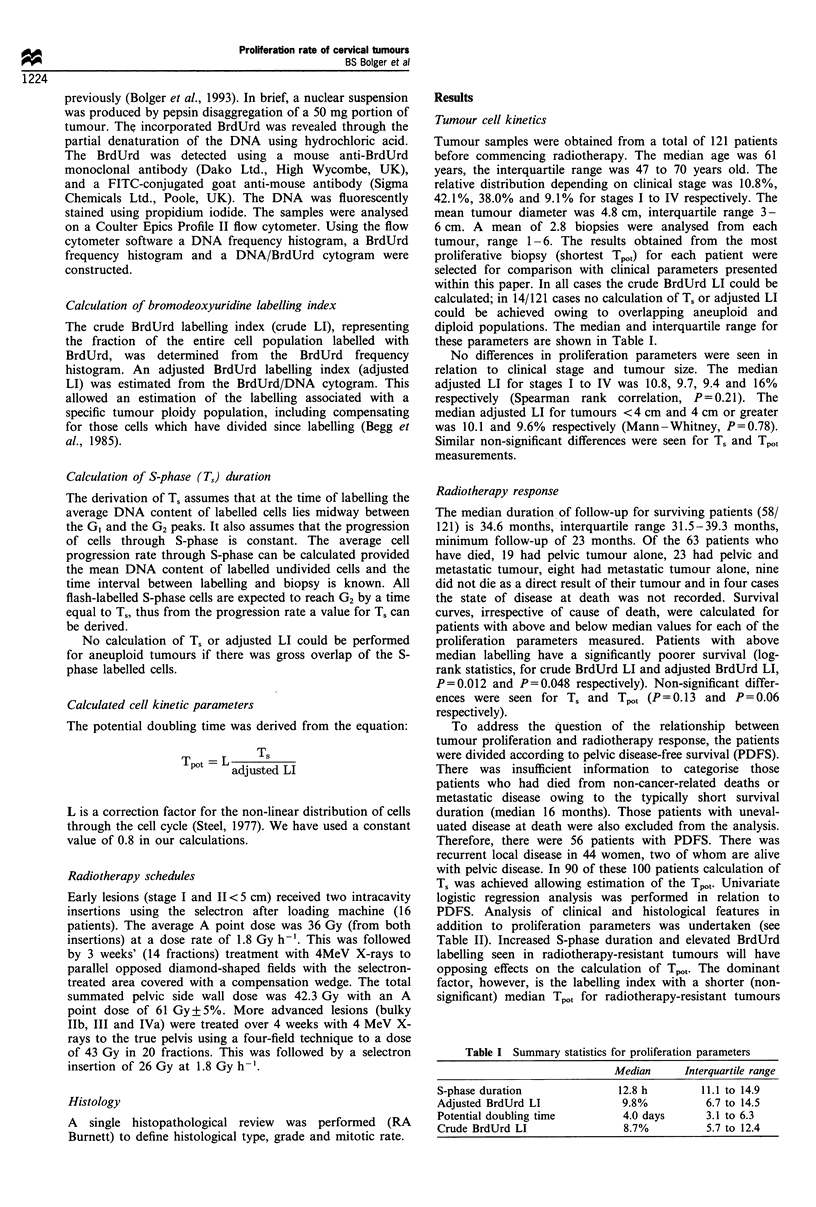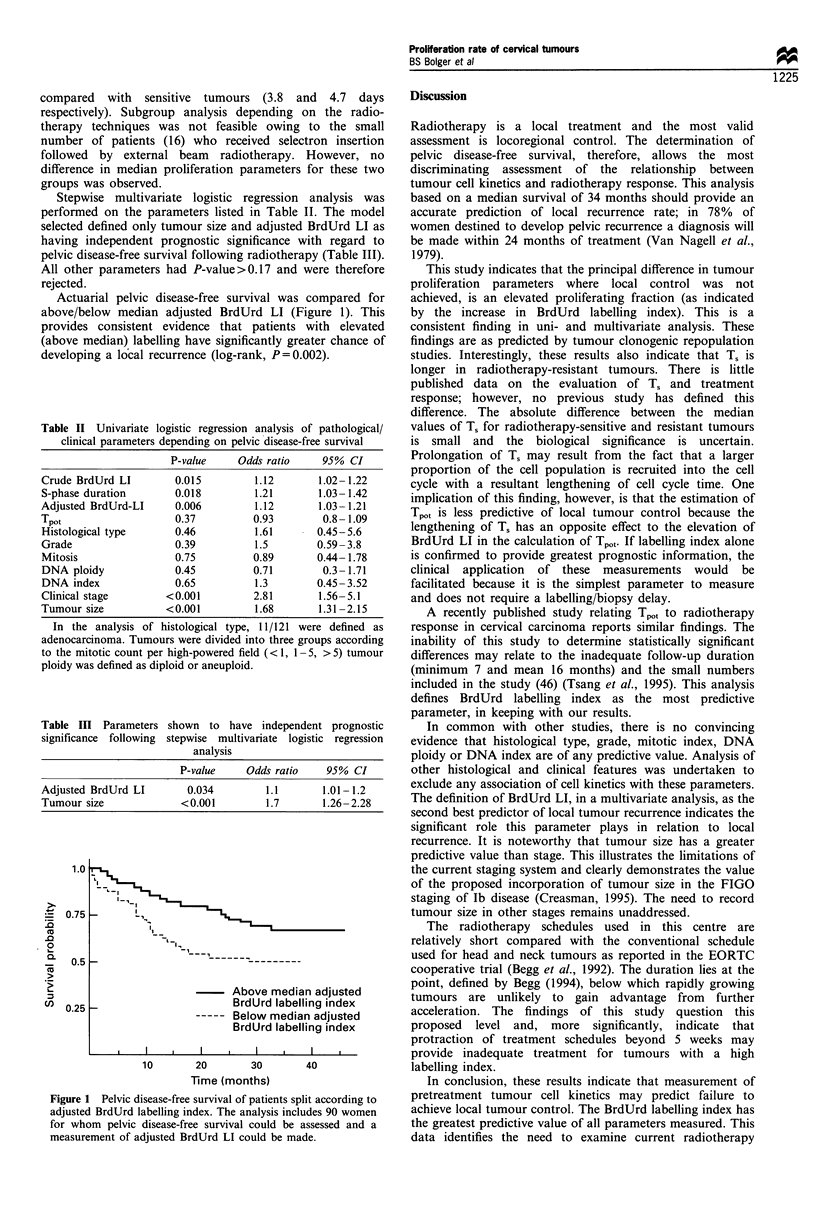Abstract
Estimation of tumour proliferation may allow the design of individualised radiotherapy schedules to optimise response. This prospective study correlates the tumour proliferation rate of cervical carcinoma with response to conventional radiotherapy. The potential tumour cell doubling rate (Tpot) was estimated following flash labelling of the tumours in vivo using the DNA precursor, bromodeoxyuridine (BrdUrd); samples were analysed by flow cytometry. Tumour ploidy, DNA index and mitotic count were also assessed as was histological grade and type. Multiple biopsies from each tumour were obtained from 121 women. The median Tpot was 4.0 days, median S-phase duration 12.8 h and median adjusted labelling index 9.8%. Higher BrdUrd labelling was seen in patients who developed pelvic tumour recurrence following radiotherapy. This was the only biological/histological parameter with univariate and multivariate significance in relation to locoregional recurrence (P = 0.006 and P = 0.034 respectively). This study represents the first assessment of Tpot in relation to long-term response of cervical tumours treated by radiotherapy treatment. The association of high BrdUrd labelling and poor pelvic disease-free survival indicates the need for further research into the potential of radiotherapy schedule alteration to reflect tumour proliferation. The predictive value may be enhanced by combination with other biological parameters.
Full text
PDF



Selected References
These references are in PubMed. This may not be the complete list of references from this article.
- Begg A. C., McNally N. J., Shrieve D. C., Kärcher H. A method to measure the duration of DNA synthesis and the potential doubling time from a single sample. Cytometry. 1985 Nov;6(6):620–626. doi: 10.1002/cyto.990060618. [DOI] [PubMed] [Google Scholar]
- Begg A. C., Moonen L., Hofland I., Dessing M., Bartelink H. Human tumour cell kinetics using a monoclonal antibody against iododeoxyuridine: intratumour sampling variations. Radiother Oncol. 1988 Apr;11(4):337–347. doi: 10.1016/0167-8140(88)90205-8. [DOI] [PubMed] [Google Scholar]
- Begg A. C. Prediction of repopulation rates and radiosensitivity in human tumours. Int J Radiat Biol. 1994 Jan;65(1):103–108. doi: 10.1080/09553009414550141. [DOI] [PubMed] [Google Scholar]
- Bolger B. S., Cooke T. G., Symonds R. P., MacLean A. B., Stanton P. D. Measurement of cell kinetics in cervical tumours using bromodeoxyuridine. Br J Cancer. 1993 Jul;68(1):166–171. doi: 10.1038/bjc.1993.307. [DOI] [PMC free article] [PubMed] [Google Scholar]
- Cole D. J., Brown D. C., Crossley E., Alcock C. J., Gatter K. C. Carcinoma of the cervix uteri: an assessment of the relationship of tumour proliferation to prognosis. Br J Cancer. 1992 May;65(5):783–785. doi: 10.1038/bjc.1992.167. [DOI] [PMC free article] [PubMed] [Google Scholar]
- Creasman W. T. New gynecologic cancer staging. Gynecol Oncol. 1995 Aug;58(2):157–158. doi: 10.1006/gyno.1995.1203. [DOI] [PubMed] [Google Scholar]
- Davidson S. E., Symonds R. P., Lamont D., Watson E. R. Does adenocarcinoma of uterine cervix have a worse prognosis than squamous carcinoma when treated by radiotherapy? Gynecol Oncol. 1989 Apr;33(1):23–26. doi: 10.1016/0090-8258(89)90596-9. [DOI] [PubMed] [Google Scholar]
- Davidson S. E., West C. M., Roberts S. A., Hendry J. H., Hunter R. D. Radiosensitivity testing of primary cervical carcinoma: evaluation of intra- and inter-tumour heterogeneity. Radiother Oncol. 1990 Aug;18(4):349–356. doi: 10.1016/0167-8140(90)90115-d. [DOI] [PubMed] [Google Scholar]
- Dixon B., Ward A. J., Joslin C. A. Pre-treatment 3H-TdR labelling of cervical biopsies: histology, staging and tumour response to radiotherapy. Clin Radiol. 1977 Sep;28(5):491–497. doi: 10.1016/s0009-9260(77)80060-3. [DOI] [PubMed] [Google Scholar]
- Levine E. L., Davidson S. E., Roberts S. A., Chadwick C. A., Potten C. S., West C. M. Apoptosis as predictor of response to radiotherapy in cervical carcinoma. Lancet. 1994 Aug 13;344(8920):472–472. doi: 10.1016/s0140-6736(94)91802-3. [DOI] [PubMed] [Google Scholar]
- Naus G. J., Zimmerman R. L. Prognostic value of flow cytophotometric DNA content analysis in single treatment stage IB-IIA squamous cell carcinoma of the cervix. Gynecol Oncol. 1991 Nov;43(2):149–153. doi: 10.1016/0090-8258(91)90062-a. [DOI] [PubMed] [Google Scholar]
- Saunders M. I., Dische S., Grosch E. J., Fermont D. C., Ashford R. F., Maher E. J., Makepeace A. R. Experience with CHART. Int J Radiat Oncol Biol Phys. 1991 Aug;21(3):871–878. doi: 10.1016/0360-3016(91)90722-g. [DOI] [PubMed] [Google Scholar]
- Strang P., Eklund G., Stendahl U., Frankendal B. S-phase rate as a predictor of early recurrences in carcinoma of the uterine cervix. Anticancer Res. 1987 Jul-Aug;7(4B):807–810. [PubMed] [Google Scholar]
- Strang P., Lindgren A., Stendahl U. Blood group antigens in relation to DNA content, S-phase rate and heterogeneity, and their prognostic values in cervical carcinoma. Anticancer Res. 1987 Jan-Feb;7(1):125–128. [PubMed] [Google Scholar]
- Tsang R. W., Fyles A. W., Kirkbride P., Levin W., Manchul L. A., Milosevic M. F., Rawlings G. A., Banerjee D., Pintilie M., Wilson G. D. Proliferation measurements with flow cytometry Tpot in cancer of the uterine cervix: correlation between two laboratories and preliminary clinical results. Int J Radiat Oncol Biol Phys. 1995 Jul 30;32(5):1319–1329. doi: 10.1016/0360-3016(95)00201-9. [DOI] [PubMed] [Google Scholar]
- Wilson G. D., McNally N. J., Dische S., Saunders M. I., Des Rochers C., Lewis A. A., Bennett M. H. Measurement of cell kinetics in human tumours in vivo using bromodeoxyuridine incorporation and flow cytometry. Br J Cancer. 1988 Oct;58(4):423–431. doi: 10.1038/bjc.1988.234. [DOI] [PMC free article] [PubMed] [Google Scholar]
- Zanetta G. M., Katzmann J. A., Keeney G. L., Kinney W. K., Cha S. S., Podratz K. C. Flow-cytometric DNA analysis of stages IB and IIA cervical carcinoma. Gynecol Oncol. 1992 Jul;46(1):13–19. doi: 10.1016/0090-8258(92)90188-o. [DOI] [PubMed] [Google Scholar]
- van Nagell J. R., Jr, Rayburn W., Donaldson E. S., Hanson M., Gay E. C., Yoneda J., Marayuma Y., Powell D. F. Therapeutic implications of patterns of recurrence in cancer of the uterine cervix. Cancer. 1979 Dec;44(6):2354–2361. doi: 10.1002/1097-0142(197912)44:6<2354::aid-cncr2820440653>3.0.co;2-j. [DOI] [PubMed] [Google Scholar]


